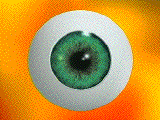
The EyeModel: A Photograph of the actual device used in clinical trials.

NEW DEVICE CORRECTS MYOPIA
without surgery
PNEUMATIC KERATOLOGY A PROCEDURE TO CORRECT MYOPIA
EyeModel
PNEUMATIC KERATOLOGY is a new procedure that corrects refractive errors, most notably myopia or nearsightedness, without the risks, complications, and expense of laser keratectomy, laser in situ keratomiulesis (LASIK), or other invasive surgical procedures.
PNEUMATIC KERATOLOGY uses a simple device (The EyeModel) which corrects myopia by means of a vacuum. The method and device is a patented invention capable of modeling the shape of the cornea by using a vacuum on the cornea of the eye. This method is much simpler than laser ablation or cutting the cornea, that is neccessary in other methods. Myopia correction is accomplished without complication.

The EyeModel: A Photograph of the actual device used in clinical trials.
The basis of PNEUMATIC KERATOLOGY is described in U.S. patent No. 5,690,123: METHOD OF ALTERING THE SHAPE OF THE CORNEA by Antonio Medina. The patent gives details on how to correct nearsightedness instantly. The EyeModel plastically changes the shape of the cornea by application of a vacuum. PNEUMATIC KERATOLOGY provides a revolutionary means to correct all refractive errors, myopia, hyperopia, and astigmatism with unprecedented simplicity. It is easier to use and much less complicated than expensive laser surgery equipment for the correction of myopia. Unlike other methods, the cornea is not cut, burnt, ablated, or damaged. No tissue is removed and nothing is implanted.
The EyeModel has elongated openings that are connected to a vacuum pump with a thin tube. By placing the device on the surface of the cornea and then applying a vacuum, a plastic deformation of the area of the cornea below the openings is achieved. The resulting effect is that the curvature and the refractive power of the cornea and the eye are changed. A flatter cornea reduces or corrects myopia or nearsightedness.
The EyeModel stretches corneal tissue, called stroma, in a preferential direction or pattern, creating a permanent plastic deformation in that direction. A vacuum chamber with radially elongated openings that are uniformly spaced corrects myopia. This is the device shown in the photograph and used successfully on live corneas. A vacuum chamber with circular openings corrects hyperopia. When the openings are not uniformly spaced, astigmatism can be corrected.
This procedure is not yet available to the general public. The information in the link below "FAQs" addresses most questions about the device, the results obtained to date and how to become a candidate for clinical trials.
inventionpress![]()
Comments/Info:
 To send your private message click below
To send your private message click below
